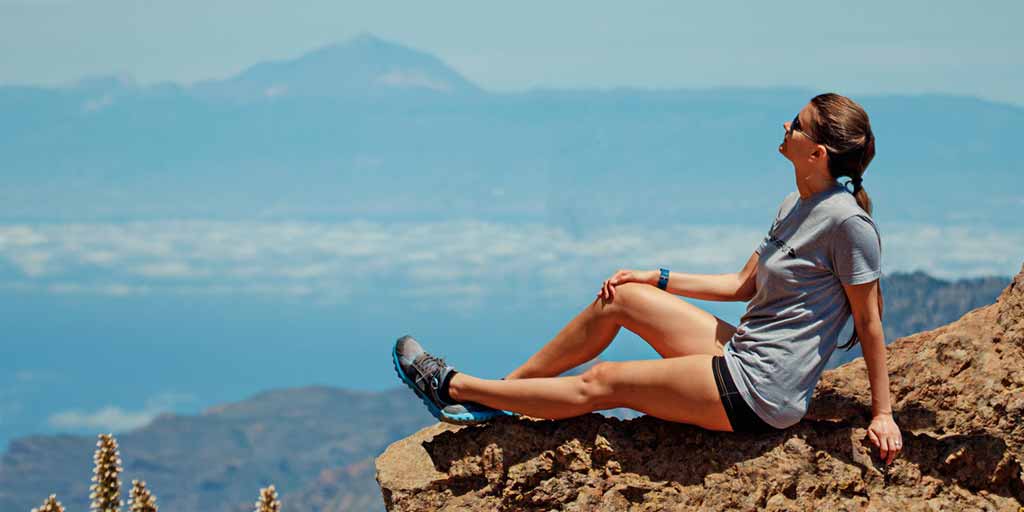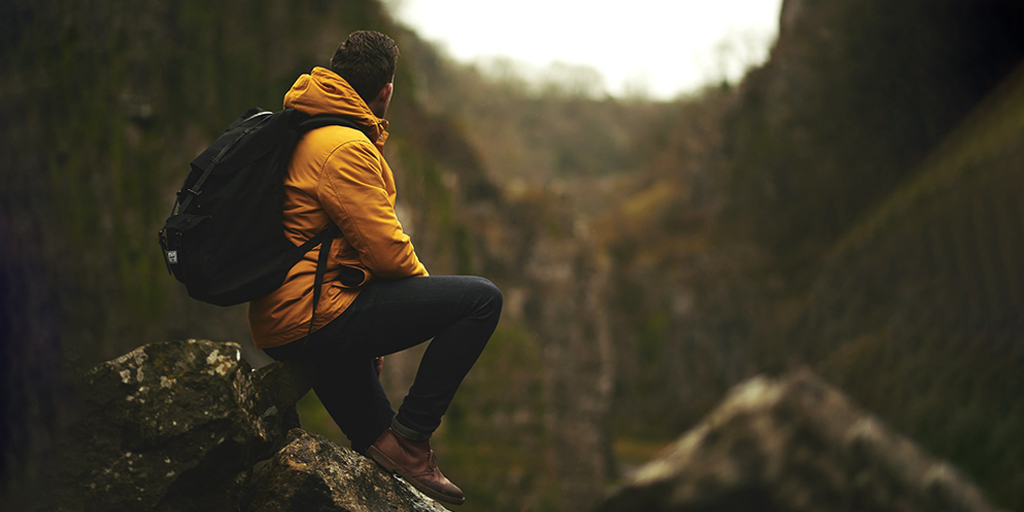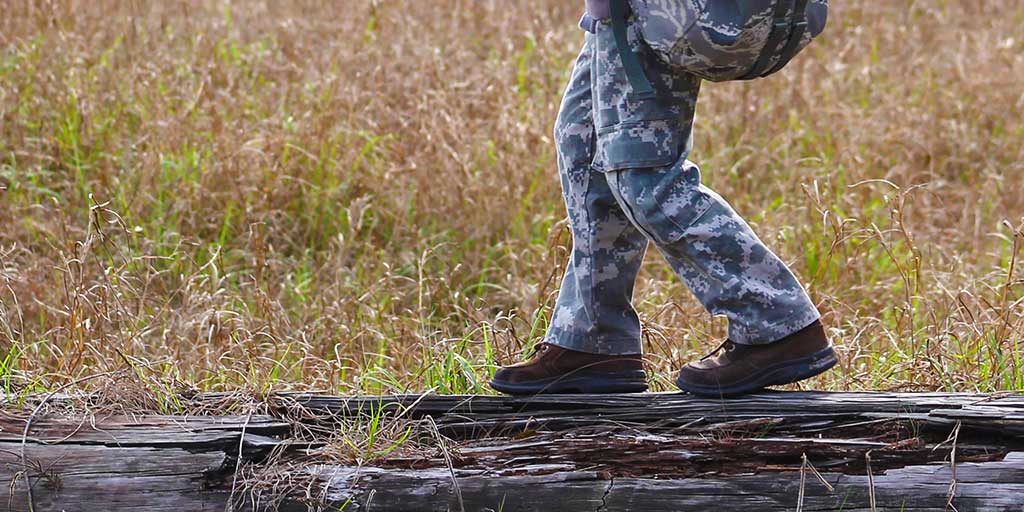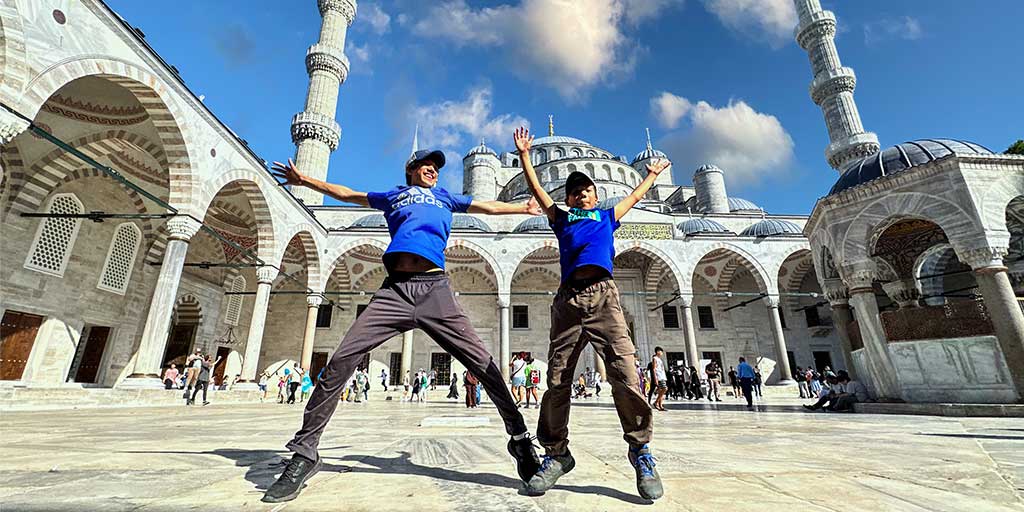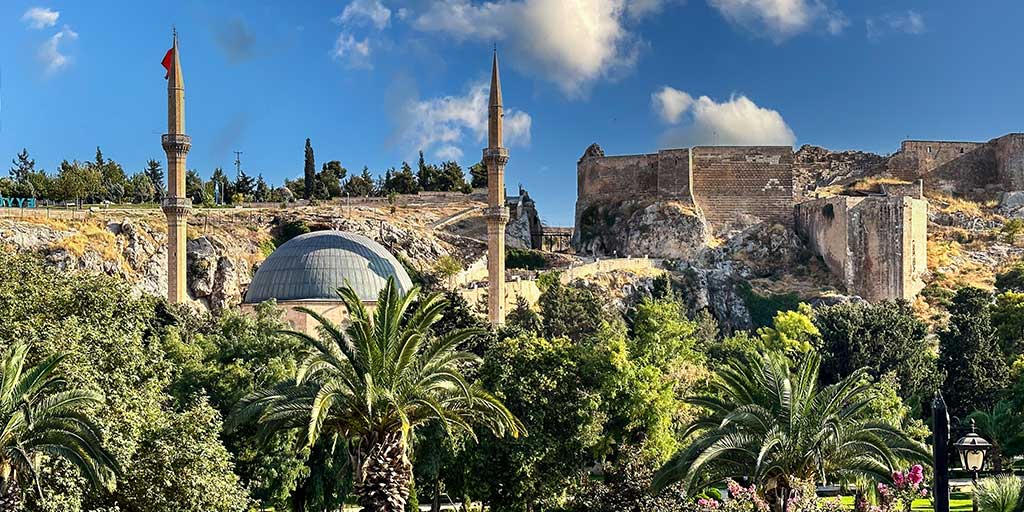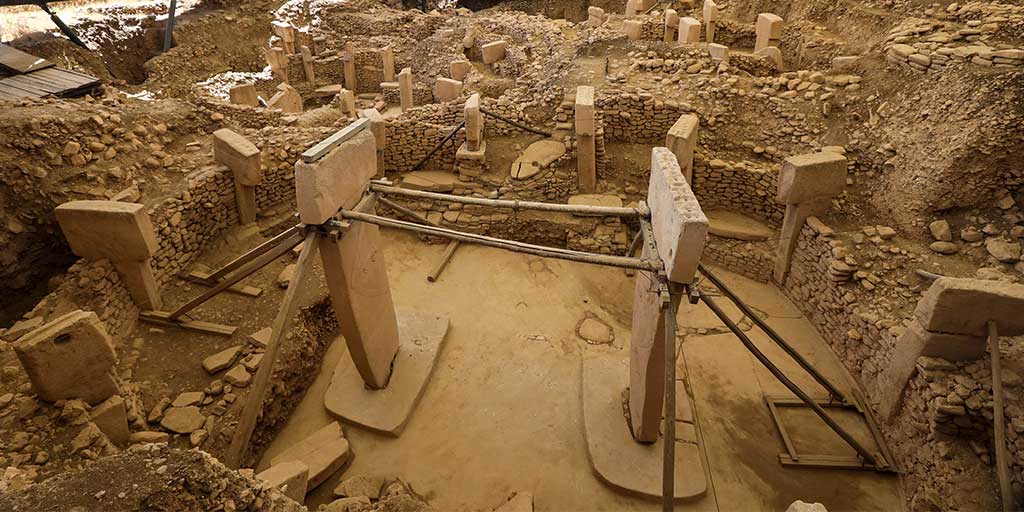Discover the awe-inspiring beauty of Mount Nemrut in Turkey with our comprehensive guide. Uncover the ancient secrets of this UNESCO World Heritage site, from colossal statues to breathtaking sunrises.
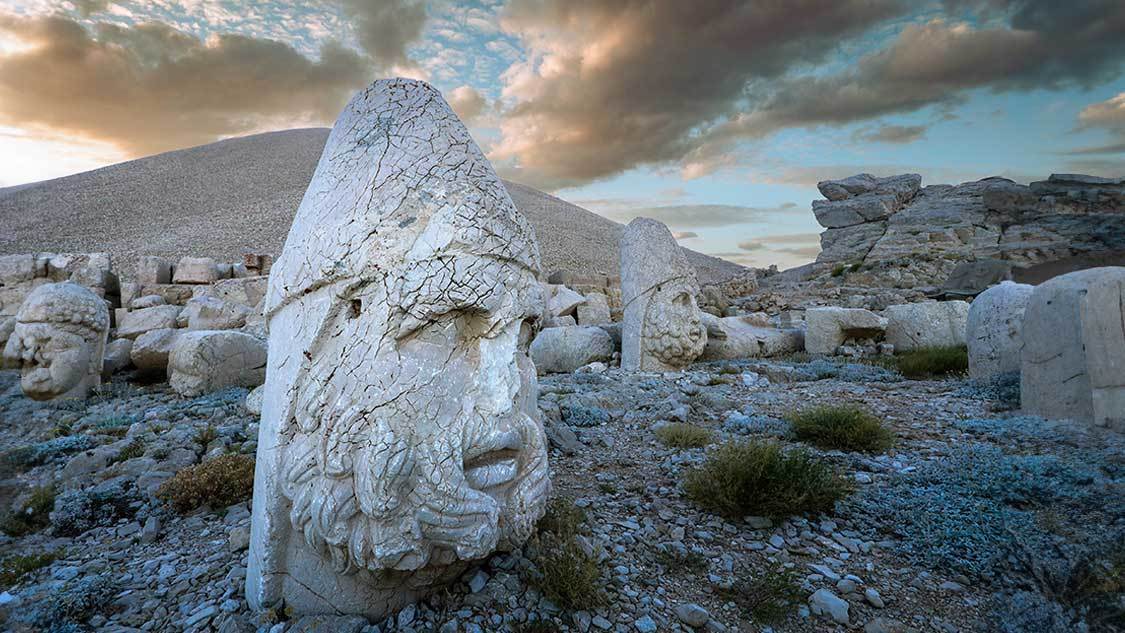
Towering 7,000 feet above the surrounding scenery on the eastern edge of southern Turkiye sits one of the most fascinating mountaintops in the world.
It was 4:00 in the morning when my family woke up for the drive to this remote mountain. By 5:00, the four of us were trekking in the pre-dawn darkness towards what would be one of the most magical sunrises we’ve ever experienced.
Mount Nemrut is among the tallest mountains in the Eastern Taurus Mountain Range, not far from the Euphrates River. At its peak lies a 2,000-year-old tomb built by King Antiochus I. Replete with massive sculptures of Greek, Armenian, and Persian figures such as Heracles, Zeus, Appollo, and Vahagn, and home to one of the most spectacular sunrises in the world, it’s a tomb fit for a God.
Or that of a King who believed himself to be one of them.
The haunting sculptures are among the most stunning examples of large-scale artwork from that age. While the details of the bodies of many of these sculptures have fallen due to earthquakes, erosion, and human destruction, the Godly heads still remain in remarkable conditions. They now sit at the base of their former stands, gazing out over the Taurus Mountains.
Their majestic location has made Mount Nemrut one of the most fascinating places to visit in Turkiye.
The History Of Mount Nemrut
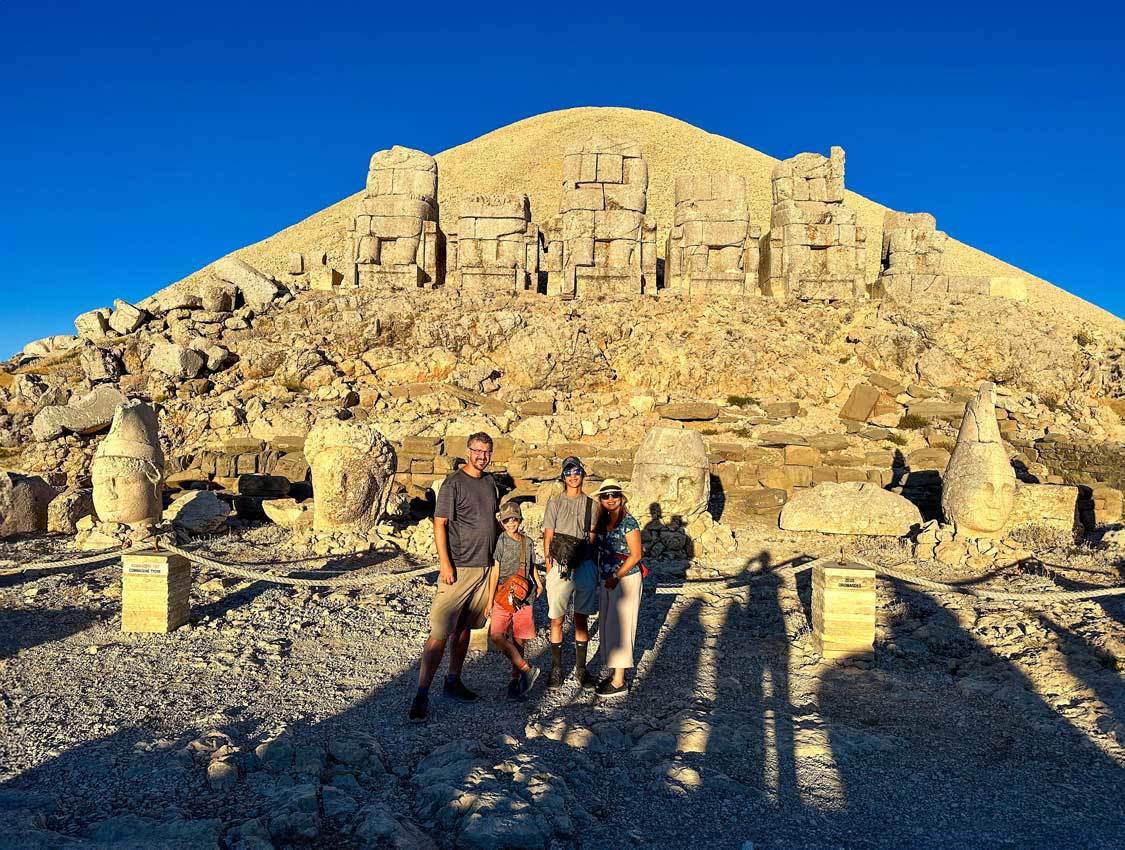
My family found their way to Mount Nemrut on the last leg of our Turkiye itinerary. We were on our way to the city of Sanliurfa after exploring Istanbul, the Turquoise Coast, and Cappadocia. On our Turkiye bucket list was the country’s far-east region, where some of its most beautiful but rarely-visited attractions lie.
One of the region’s most magical places to visit is Mount Nemrut, a gorgeous mountain-top tomb built by King Antiochus I. A King who wanted to be remembered, not for his love of the gods, but as a god himself.
It was one of the most incredible mornings of our entire trip. As the sun lit up the peak of Mount Nemrut, it was like the entire world came alive around us. We spent two hours exploring the monuments and statues that decorate the tomb before heading out to explore more of the wonders of the Adiyaman province.
Antiochus I lived from 68-31 BCE. He was king of the Greco-Iranian Kingdom of Commagene from 70-31 BCE and was one of the last rulers of the Persian-Macedonian court of Commagene before its overthrow by the Roman Empire.
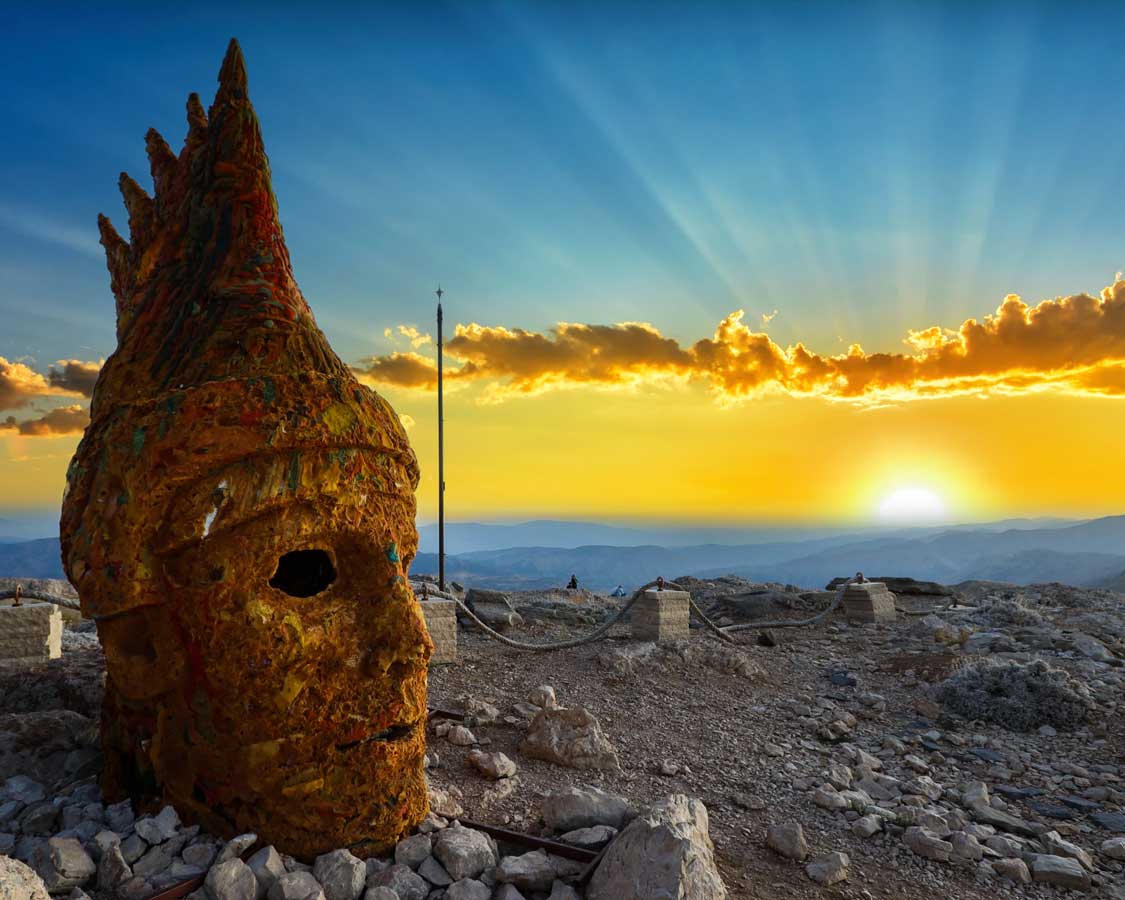
During the first century BCE, Commagene, which borders the region of Cappadocia to the west, was seeing a revival of Persian revival after swinging mostly to Greek beliefs. During his rule, Antiochus I tread between the two beliefs, also flirting with the beliefs of ancient Armenia.
During his reign, Antiochus I created his own cult with the goal of being worshipped as a God after his death as a Greek form fused with Zoroastrianism, an ancient Iranian religion. He decreed that his tomb should be constructed in a remote place close to the Gods. A tomb in which he would be deified and worshipped as one of them.
The tomb at Mount Nemrut was built in 62 BCE as the final resting place for Antiochus. It was designed with statues of lions, eagles, and Greek, Armenian, and Iranian deities that included Heracles-Artagnes-Ares, and Apollo-Mithras-Helios-Hermes (the same deities often went by several names under different belief systems).
The mountaintop construction of this incredible monument is considered to be one of the greatest architectural accomplishments of the Hellenistic period. Each morning, the statues, which line both the eastern and western sides of Mount Nemrut, gaze out over impressive sunsets and sunrises.
Upon their construction, these statues were over 30 feet tall and weighed over 6 tons.
Our Experience Visiting Mount Nemrut
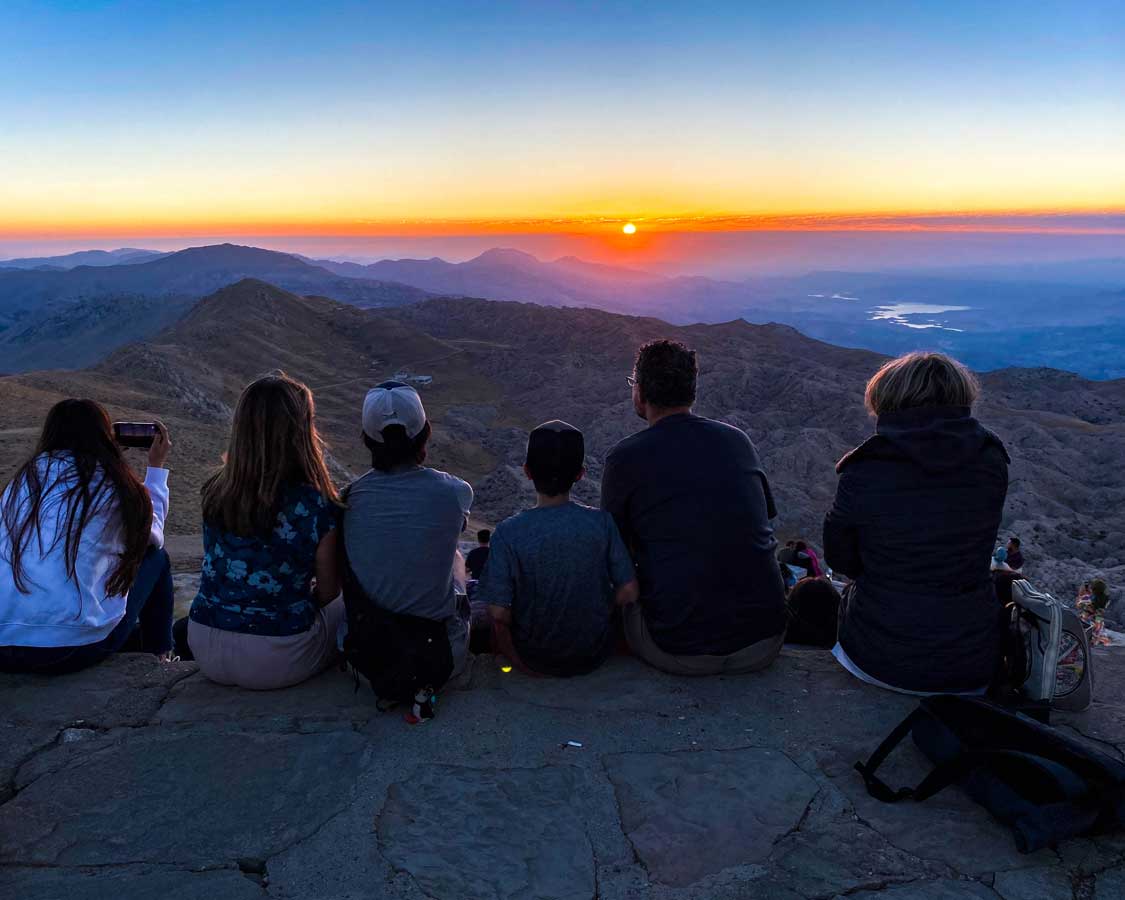
We had arrived in Nemrut, Turkiye, late the previous night after having spent four nights at some luxurious cave hotels in Cappadocia. We were picked up at the Gaziantep. We had flown Taha Airlines from Nevsehir near Goreme.
We were all exhausted after exploring all of the things to do in Cappadocia, so we slept almost the entire drive to the Hotel Euphrate in Nemrut.
Because Mount Nemrut is very remote, we wanted to book a hotel close by. We knew we weren’t going to be spending much time here, so we weren’t looking for anything fancy. But the hotel ended up having a decent breakfast with an incredible view from their dining patio and a pool that we would all have a chance to use later in the day.
We were picked up at about 4:00 am by Taho, an absolutely fantastic guide from Tours by Locals, whom we had booked while back home in Toronto. He is the same guide who is an expert on the fascinating Gobekli Tepe ruins, the oldest known building complex in the world, which we would visit the following day.
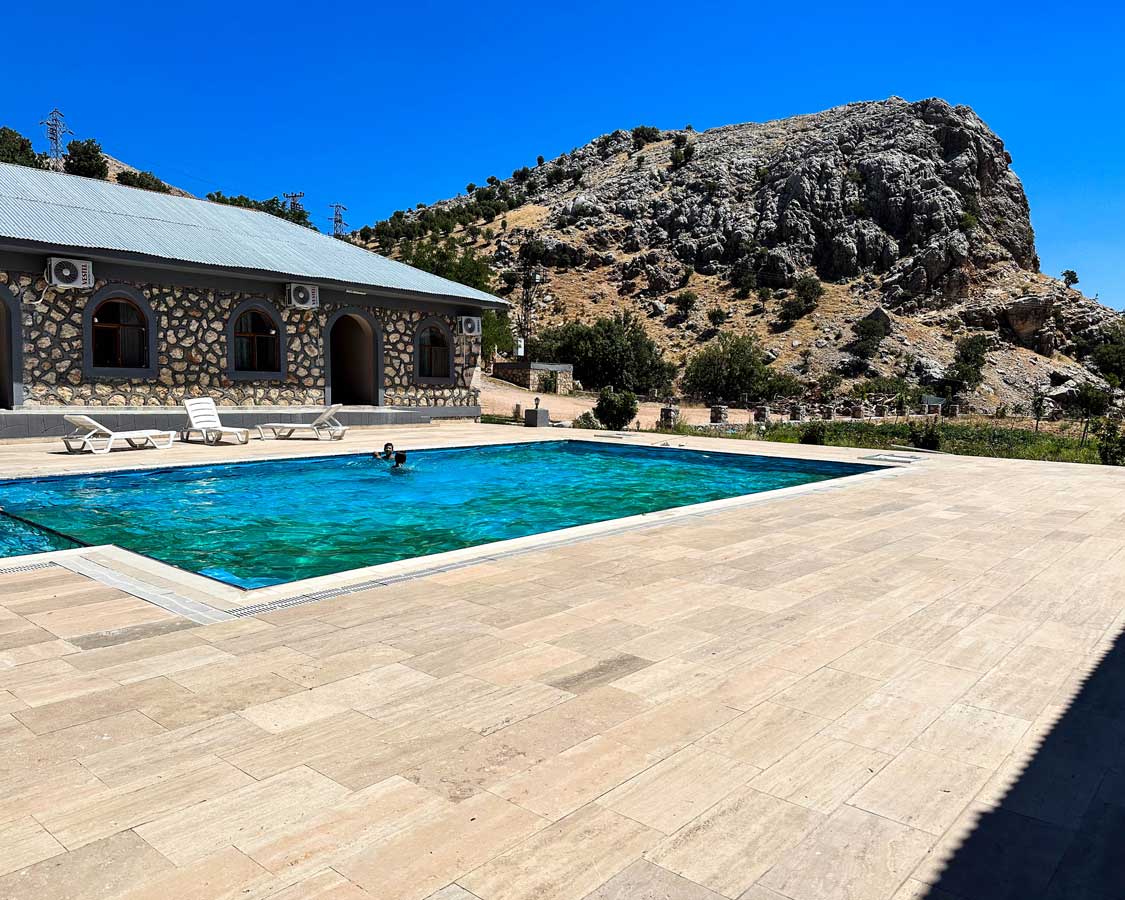
We were bleary-eyed. And dragging the boys out of bed for the pre-dawn drive was a challenge. But soon, we were loaded up in the van and on our way for the hour-long drive to the Mount Nemrut parking lot.
The parking lot for Mount Nemrut is located on the west side of the mountain, so there was almost complete darkness when we arrived. There was a choice of two ways up to the peak of Mount Nemrut. The most common is a cleared path that winds along north-side switchbacks to the mountain peak, and the other is along an ancient stairway on the south side.
We opted for that route because it sounded cooler. And it was. The route was uneven and disappeared from time to time, but it felt far more like walking in the footsteps of history than the modern trail we would later take to descend the mountain.
As we arrived at the summit, the hint of the new dawn light was starting to shimmer above the horizon. Crowds of friends and tour groups gathered on a large viewing platform to watch the surrounding scenery come to life.
While much of the attention was on the golden rays of the rising sun rising above Mount Nemrut, my attention wavered to the now visible colossal statues of King Antiochus I and those he considered his peers.
The massive heads of these godly statues sat at the base of the thrones and bodies upon which they once stood, and the morning light almost made them look alive, as if they would start speaking to us.
Along the eastern side of Mount Nemrut were a number of other sites, including ancient walls and a foam art installation by King Antiochus I, which was situated in such a way that it caught the rays of the sunrise perfectly.
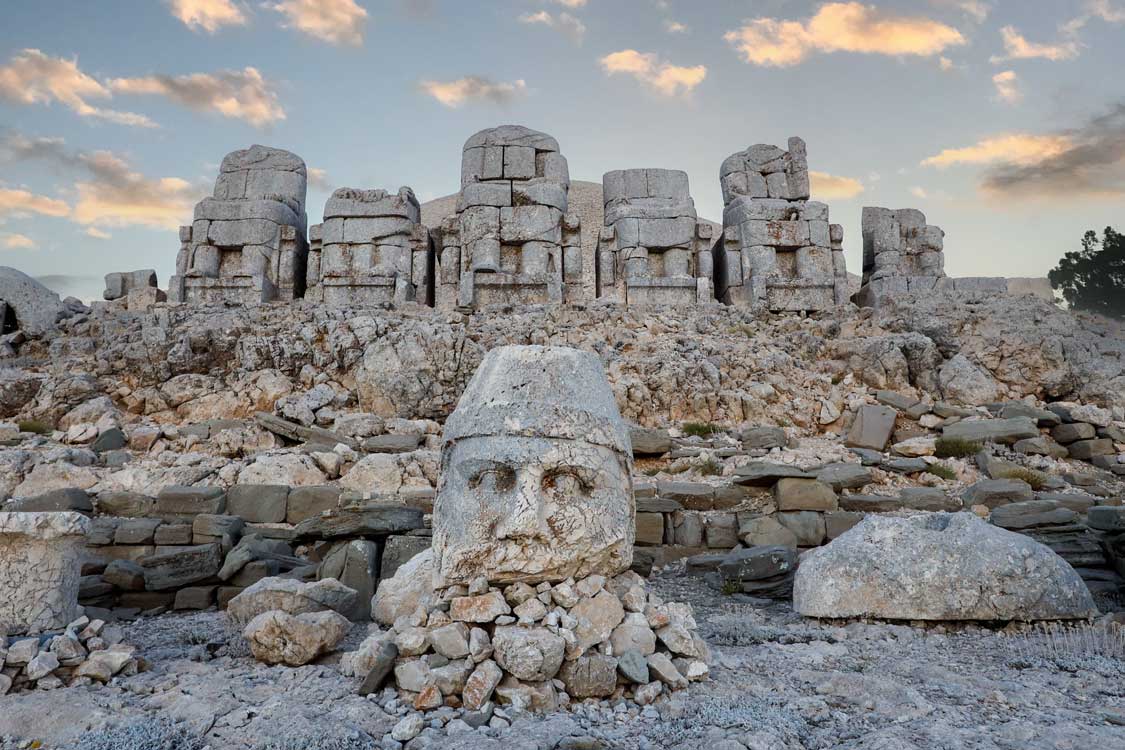
After watching the sun climb above the horizon, we spent about an hour and a half strolling around the Mount Nemrut summit, exploring the ruins and sculptures. On the western side is a similar display of godly statues that have not weathered the years, as well as those on the eastern side. But they were still very much worth checking out.
AFter we had our fill and the kid’s attention began to wane, we made our way down the winding switchbacks to the van and back to the Hotel Euphrates for some breakfast, a swim, and a nap before heading out for a day of adventure that would take us to the Severan Bridge, Karakus Tumulus, Arsameia, and to Halfeti for a boat tour of the lakes underground city.
Finally, we made our way to the city of Salifiura, exhausted and ready for some sleep.
Where Is Mount Nemrut?
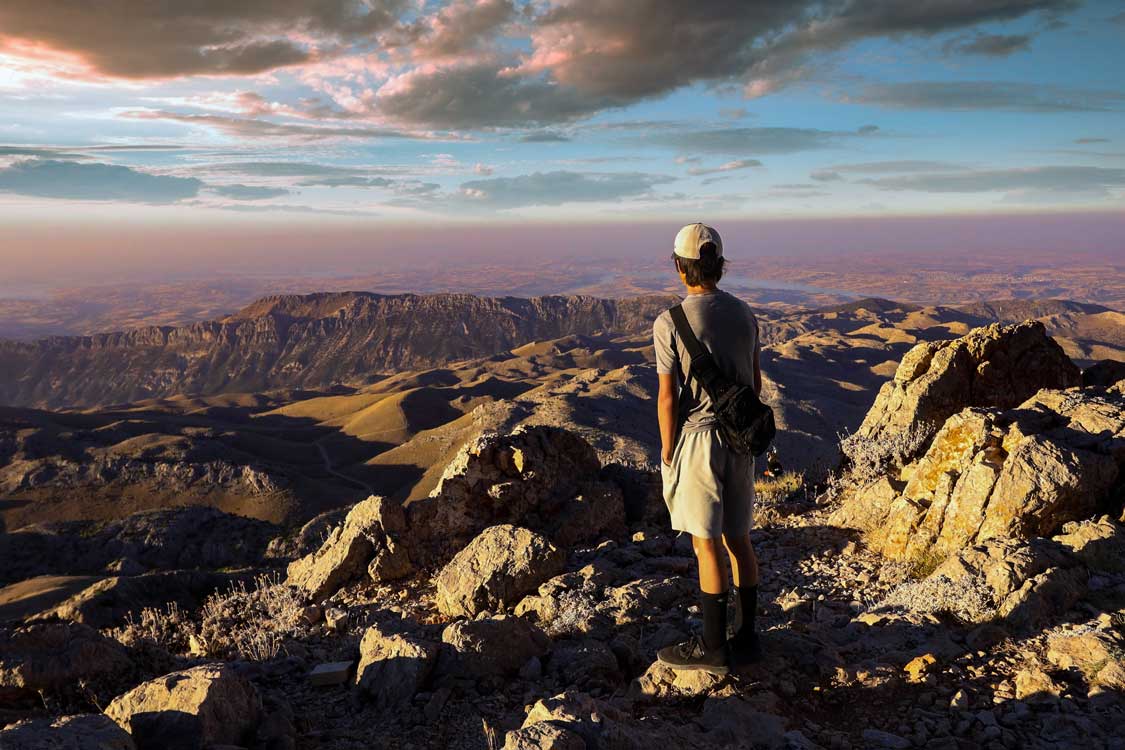
Mount Nemrut is located in a remote region of the southeastern Turkish region of Adiyaman. The closest major city to the mountaintop tomb is Adiyaman, but most visitors who book tours to Mount Nemrut fly into Gaziantep.
Mount Nemrut lies about two hours northeast of Andiyaman and about four hours northeast of Gaziantep. Those with access to a car will likely drive the winding route past the Severan Bridge and along some of the region’s incredible historical sites, such as Karakus Tumulus, the Arsameia, and the Halfeti Sunken City. There are several tours that include a collection of these experiences.
When Is The Best Time To Visit Mount Nemrut?
Most visitors aim to visit Mount Nemrut at sunrise when the morning sun lights up the colossal statues on the east side, lighting up the statue of King Antiochus I.
The mountain can experience a severe amount of snow during the winter months. Therefore, it’s best to time your visit to Mount Nemrut between May and September. Roads are sometimes clear as early as mid-March and as late as mid-November.
Because Mount Nemrut is a tall mountain, the weather can change abruptly throughout the year, and it’s not rare for it to snow, even during the summer. Although it rarely stays on the ground.
Our Southeast Turkey Travel Video
Interested in exploring more about travel in Sanliurfa and the rest of Southeast Turkey? Check out our YouTube video that shares our experiences through Mount Nemrut, Arsameia, Severan Bridge, Sanliurfa, Gobekli Tepe, and Harran.
Tips For Visiting Mount Nemrut
Mount Nemrut is a truly spectacular destination. But any extreme destination requires some planning ahead of time. Here are some tips to know before you go.
Time Your Visit For Sunrise Or Sunset
Sunrise is the most spectacular time to visit Mount Nemrut. the sun rising over the Taurus Mountains and lighting up the colossal statues shouldn’t be missed. But it does mean rising very early to make the long and windy drive to the closest parking lot, followed by a steep hike to the mountain top.
A close second is sunset. Although it’s much warmer at sunset on Mount Nemrut than it is at sunrise, it also tends to be much more windy.
Dress Warmly
It can be quite cold and windy at the peak of Mount Nemrut. I highly recommend bringing a packable jacket. You can wear it for the climb and pack it away as the sun warms up the air around you. You may also consider bringing a warm hat and gloves.
Don’t Forget Water
There are no shops or water facilities on Mount Nemrut. You’ll need to bring anything that you want to have while you’re there with you. I highly recommend bringing a filtered water bottle that cuts down on garbage and allows you to use any water source. Access to clean water is an important part of staying healthy while traveling.
Wear Good Footwear
There is a parking lot partway up Mount Nemrut, but you’ll need to climb most of the rest of the way along an ancient stairway or a steep path. It’s a long, slippery climb, especially in the pre-dawn darkness. Make sure that you wear good shoes with ankle support to avoid injury.
Things To Do Near Mount Nemrut
Mount Nemrut is unforgettable. But you’ll likely be visiting this incredible mountain top tomb first thing in the morning, so you’ll have an entire day to explore all of the places to visit nearby as well. Here are some of the places nearby that we explored.
Arsameia
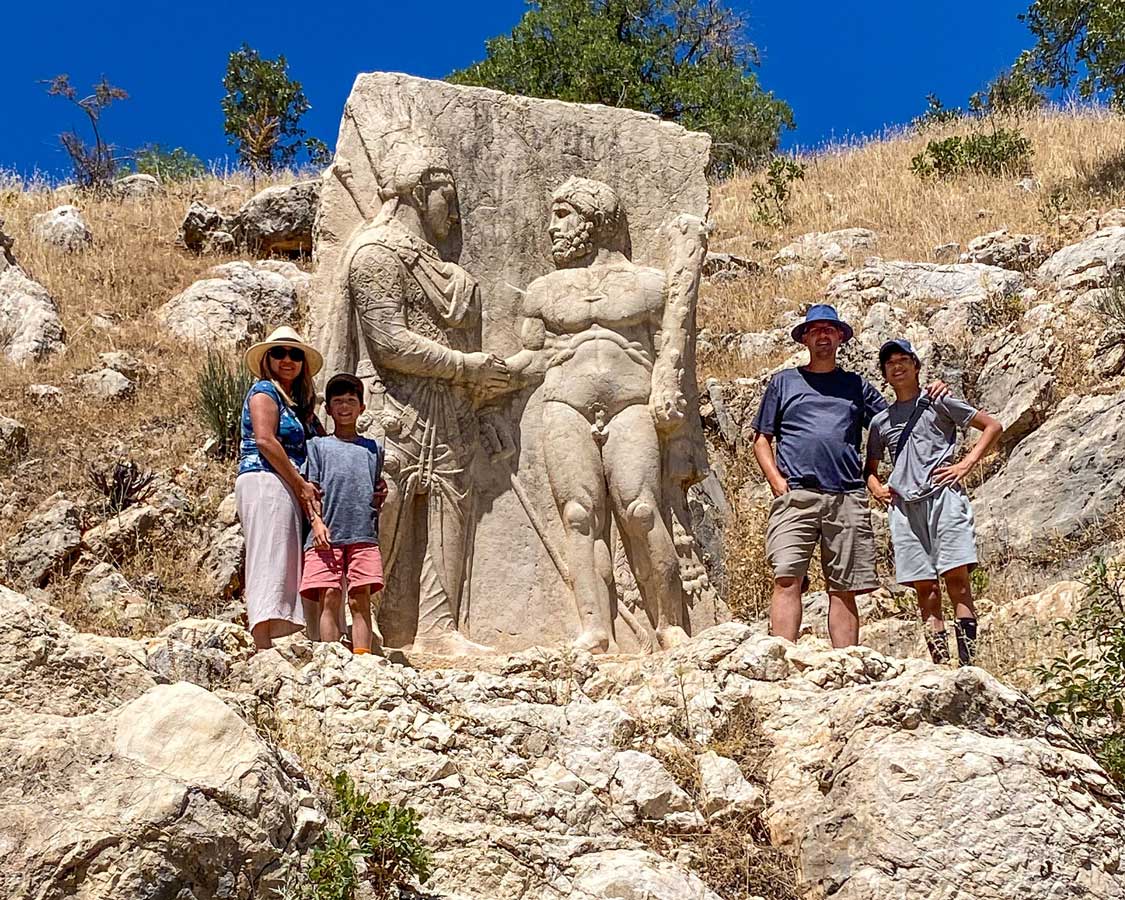
Access to Arsameia is currently closed. But, if you’re with a private tour guide, you may still be able to get a sneak peak. We were with a guide from Tours by Locals who was able to use his contacts to get us access to the site.
Arsameia dates back to the 3rd century BCE and was the summer residence of the rulers of Commagene, including Antiochus I. There are a number of underground chambers, most of which are not accessible due to recent earthquakes. But there are barred entrances where you can sneak a peak of what’s inside.
The most notable surviving monument is a detailed stele relief. It’s believed to be the first depiction of the God Mithras-Helios. Arsameia is about an hour southwest of Mount Nemrut
Severan Bridge
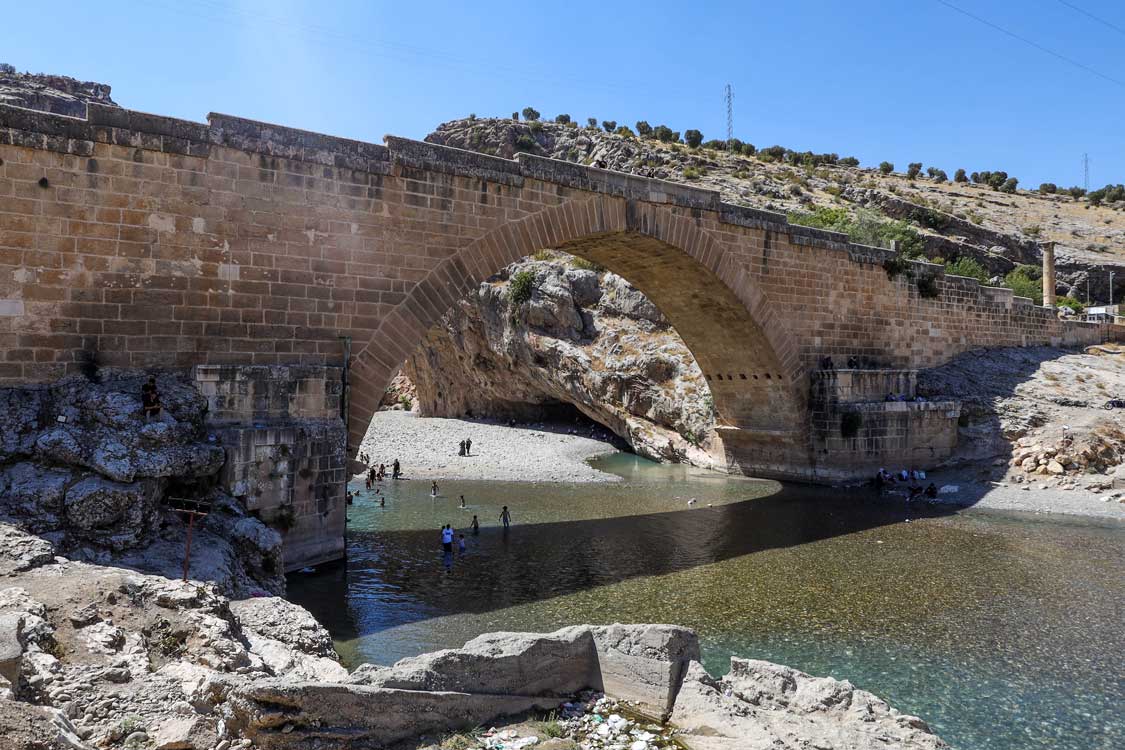
Located just 20-minutes from Arsameia is the Severan Bridge (also known as Chabinas Bridge, Cendere Bridge, and Septimius Severus Bridge). This remarkable piece of engineering was built in the 2nd century CE on the orders of Roman Emperor Lucius Septimius Severus in honor of his two sons.
This simple but beautiful bridge has withstood two millennia of earthquakes, floods, and human use. In fact, it was still open to vehicle traffic until 2015.
The location of the bridge is likely as important as its structure. It’s located at the mouth of a beautiful gorge spanning the Gendere Stream. It’s a very popular camping and picnic spot for locals. Unfortunately, many visitors to the bridge come for family outings and simply leave their glass, garbage, and burning fire pits behind, and the location itself suffers from this.
Karakus Tumulus
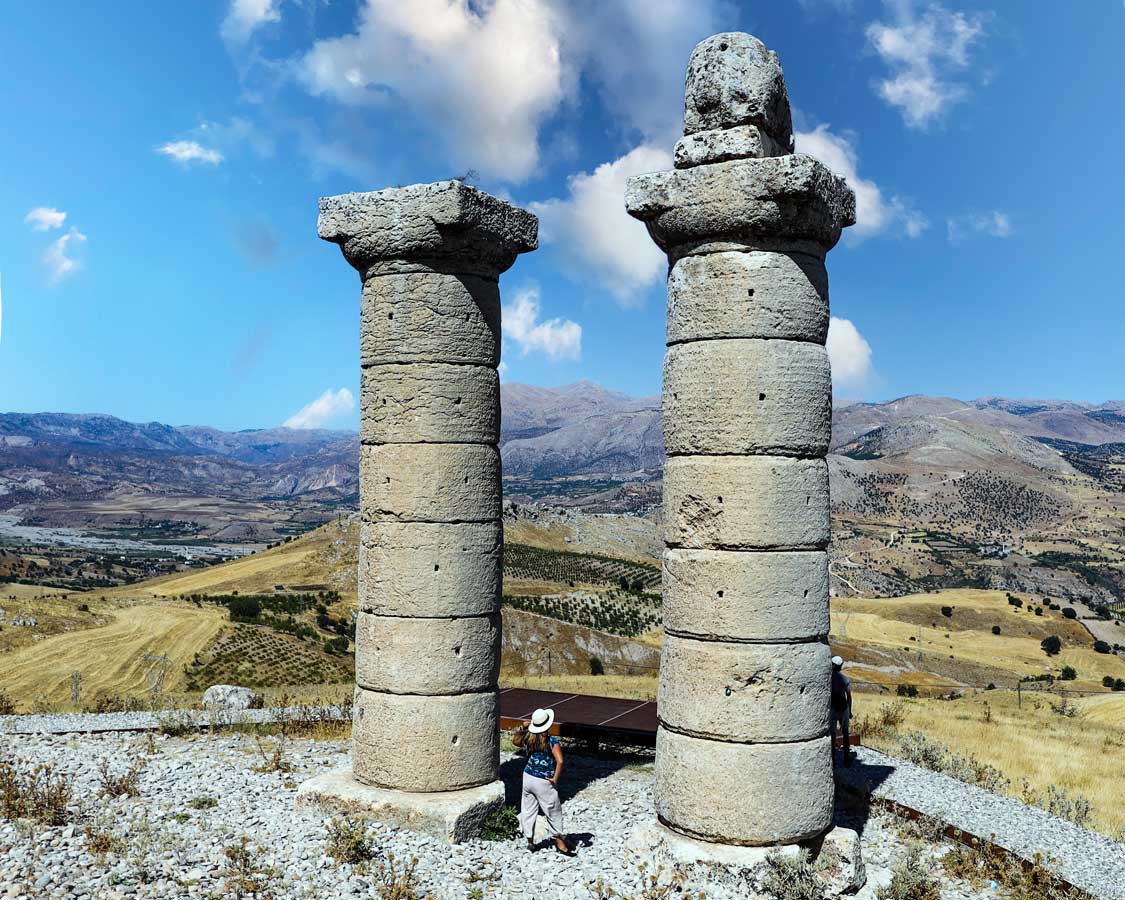
Karakus Tumulus is a fascinating stop just 15 minutes from the Severan Bridge and an hour from Mount Nemrut. This mesmerizing burial site was built by the father of Antiochus I, Mithridates II, in 30-20 BCE in honor of his sister Laodice, along with his mother and niece.
The site contains a series of beautiful columns topped with figures, including an eagle and a bull. The tomb itself was looted ages ago, but the views from the circular trail around the site are spectacular.
Tips For Family Travel In Turkiye
Family travel in Turkiye, especially in places like Sanliurfa and the Southeast, requires some planning and a little bit of luck. Some areas of this country can be closed due to political unrest, so it’s always a good idea to check out current travel advisories and stay informed of the current travel status.
Check out our Turkiye Family Travel Blog for everything that you need to know about family travel in Turkiye and watch ouf Tips for Family Travel in Turkiye video below to help you plan an unforgettable visit to this mesmerizing and wonderful country.
You’d be doing us a huge favor if you could hit the like and subscribe buttons.
Enjoy Your Time Visiting Mount Nemrut, Turkiye
Climbing to the summit of Mount Nemrut was one of the highlights of our Turkiye itinerary. This destination oozes history, and the views from the summit are simply spectacular. It’s quite a remote destination, but if you have the time, I highly recommend adding this to your list of places to visit in Turkiye.
I hope that these tips for visiting Mount Nemrut were helpful. If I missed anything, please feel free to drop a comment below, reach out via our contact page, or chat with us on our social media channels.
You can find valuable tips about visiting Turkiye on our Turkiye Family Travel Blog. Or feel free to join our Family Travel Support Group on Facebook. You can connect with more family travelers just like you who love to explore the world.
Wandering Wagars is a participant in the Amazon Services LLC Associates Program, an affiliate advertising program designed to provide a means for sites to earn advertising fees by advertising and linking to amazon.com, amazon.co.uk, amazon.ca. Amazon and the Amazon logo are trademarks of Amazon.com, Inc. or its affiliates
You May Also Like To Read:

